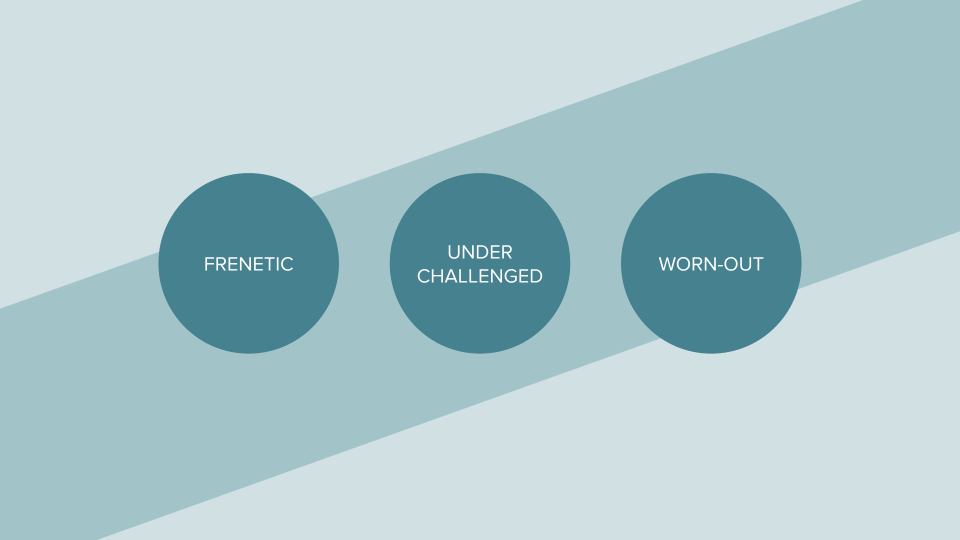Burnout has been traditionally defined as a combination of exhaustion, cynicism, and inefficiency. When we are burned out, we don’t have the emotional energy to invest ourselves into work, we distance ourselves from colleagues and customers, and we may feel incompetent as a result.
While the dimensions of exhaustion, cynicism and inefficiency give us a good idea of all the ways burnout can affect us, they don’t address why some people are affected differently. Why is it that two people in a similar role, with similar team support, and similar levels of pressure react differently to burnout?
A team at the Department of Psychiatry from the University of Zaragoza in Spain decided to design a more helpful framework to understand the many subtypes of burnout, based on how we cope when burning out.
Your burnout profile
While the global prevalence of burnout is unknown, it’s a common syndrome which has been recognised as an occupational phenomenon” by the World Health Organization in the latest International Classification of Diseases. It can happen to anyone, and often starts earlier in a career than you would expect. In her book Anxiety, Sonali Gupta writes: “Most millennials who start jobs by age twenty one reach their first burnout when they are about twenty six to twenty seven years old. Their second burnout is between age twenty nine and thirty years.This is usually the time when most people reach out for help and almost believe in its legitimacy since they now feel that a decade of work has taken a toll on them.”
For years, burnout has been treated as a homogenous syndrome, when in reality people’s experiences with burnout vary greatly. “Burnout is considered a uniform condition with relatively consistent symptoms resulting from prolonged exposure to chronic stressors in the workplace. […] Clinical experience, however, shows that burnout is manifested in different ways that can be classified depending on the level of dedication with which individuals cope with work-related tasks,” the researchers from the University of Zaragoza explain.
According to their framework, how we cope with burnout can be used to define the type of burnout we are experiencing:
- The frenetic worker. You keep on frantically working despite feeling overwhelmed and overloaded with work, overlooking your own needs in order to fulfil your work demands. In the words of the researchers: “The frenetic burnout type works increasingly harder, to the point of exhaustion, in search of success, and presents involvement, ambition and overload.”
- The under-challenged worker. You can see this type of burnout as the opposite of the first one. You feel like your work doesn’t offer you opportunities to develop your abilities: “The under-challenged type has to cope with monotonous and unstimulating conditions that fail to provide satisfaction and feels indifference, boredom and lack of personal development.”
- The worn-out worker. You are mentally, emotionally, and physically exhausted. When things at work don’t turn out as well as they should, you stop trying. As a result, you become passive and unmotivated.
Whatever your profile is, burnout is not necessarily just an individual experience. It can be shared, and even become contagious. “The frenetic subtype would complain about the organisational hierarchy, which imposes limits to his or her high ambition; the underchallenged subtype would express distress about the routine nature of his or her obligations, which would hinder personal development; and the worn-out subtype would be annoyed by the monitoring systems, owing to his or her negligent behaviour. The perception of continuous complaints by colleagues could increase the emotional exhaustion experienced and contribute to the development of negative attitudes, creating a type of contagion mechanism for spreading the syndrome to other colleagues in the workplace,” write the researchers. So how can we deal with burnout in ourselves, and avoid seeing it spread to other colleagues?
Coping with burnout
“In the long term, the key factor for developing the burnout syndrome seems to be the degree of passivity that the subject acquires.” However, not everyone is passive in the face of burnout. In their paper, researchers listed fifteen different coping strategies used by people experiencing burnout. As you will see from the list, some coping mechanisms are healthier than others:
- Social support
- Religion
- Humour
- Substance use
- Planning
- Behavioural disengagement
- Venting of emotions
- Acceptance
- Denial
- Restraint
- Focus on solving situations
- Personal growth
- Positive reinterpretation
- Distracting activities
- Cognitive avoidance
Seeking social support, deflating the situation with humour, better planning our workload, accepting our emotional and psychological struggle, focusing on solving the problem, and positively reinterpreting our challenges are all constructive coping mechanisms. On the other hand, drowning our emotions in alcohol, disengaging, venting, and denying the situation are not so helpful—and may negatively affect your colleagues.
Regardless of the coping strategies you decide to experiment with, the earlier you spot the signs of burnout, the better. Beyond the obvious impact on your mental health, burnout can also sap your creativity. Do not try to push through it. Instead, get support, take a break, and make space for self-reflection.

